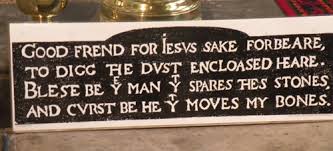Shakespeare’s grave is in Holy Trinity Church, his local parish church in Stratford upon Avon. Shakespeare died on his birthday – 23 April – in 1616, the day he turned 52.
Shakespeare’s grave is famous for having a curse as an epitaph on its’ gravestone which Shakespeare himself wrote. Relic hunting was popular in Shakespeare’s day, and Shakespeare was aware his status as a leading writer may have meant his bones would be dug up by one of the hunters. The curse on Shakespeare’s grave warns:
Good friend for Jesus sake forbeare,
To dig the dust enclosed here.
Blessed be the man that spares these stones,
And cursed be he that moves my bones.

The curse written on Shakespeare’s grave
It was unusual for anyone to be buried inside the church (rather than in the surrounding graveyard), and Shakespeare managed this by buying a tithe deed for £440 which gave him the right to have a grave in the chancel of the church, to have his final resting place alongside other family members.
When did Shakespeare die?
William Shakespeare died on 23 April 1616, his 52nd birthday. In truth, the exact date of Shakespeare’s death is not known but assumed from a record of his burial two days later, 25 April 1616, at Holy Trinity Church. Stratford upon Avon, where his grave remains.
The last months of Shakespeare’s life were embroiled in scandal after his daughter Judith’s husband Thomas Quiney was brought before the church court at Holy Trinity Church. Thomas was made to do penance for getting another woman pregnant who then died in childbirth – a likely reason behind Shakespeare rewriting his will on 25 March 16167. Within weeks of writing his new will, Shakespeare was dead.
In 1621 Shakespeare’s son-in-law commissioned The Holy Trinity Bust – a monument to The Bard made by Gerard Jansen which stands above Shakespeare’s grave in the church. It was made while Shakespeare’s wife was still alive, so is generally thought that it is a good likeness of the poet. The inscription on The Holy Trinity Bust by Shakespeare’s grave reads:
Judicio Pylium, genio Socratem, arte Maronem
Terra tegit, populus moeret, Olympus habet.
Stay, passenger, why goest thou by so fast?
Read, if thou canst, whom envious death hath placed
Within this monument: Shakespeare, with whom
Quick nature doed; whose name doth deck his tomb
Far more than cost; sith all that he had writ
Leaves living art but page to serve his wit.
Obiit ano doi [anno domini] 1616. Aetatis 53. Die 23 Ap.
Picture of Shakespeare’s Grave
Visiting Shakespeare’s Grave
Holy Trinity Church is open to the public, so anyone can walk in and visit Shakespeare’s grave. Be sure to check out the opening hours of the church before you visit: http://www.stratford-upon-avon.org/opening-times





this is good information but it has no information on his famalis graves
thank you for the information
By the end of the century, Shakespeare is known to have moved to London and was pursuing a career as an actor and a playwright. In 1598 he appeared in
how did Shakespeare’s son die
Hamnet died of unknown causes at 11 years old, though some people believe he died of bubonic plague.
What happened to Thomas after?